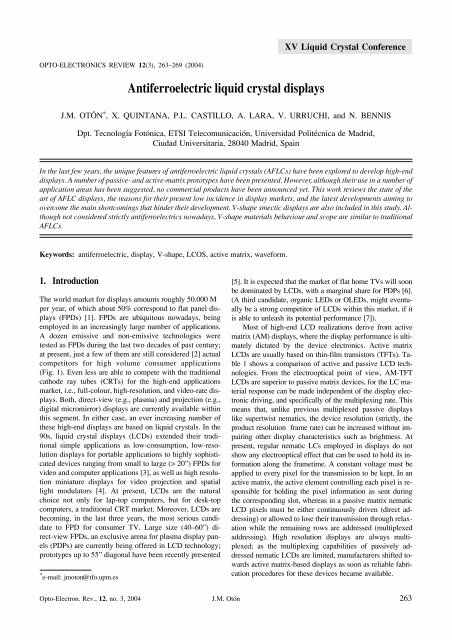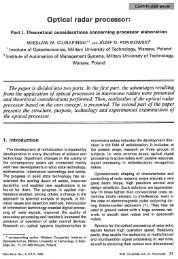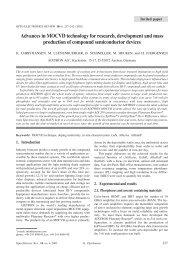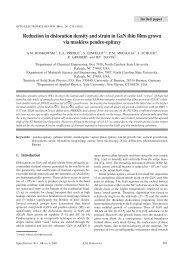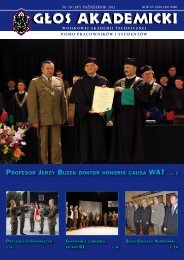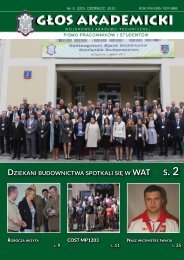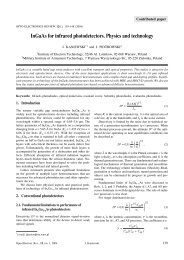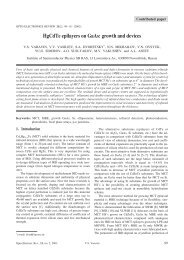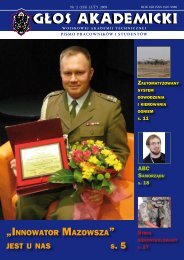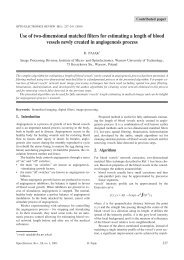Antiferroelectric liquid crystal displays - ResearchGate
Antiferroelectric liquid crystal displays - ResearchGate
Antiferroelectric liquid crystal displays - ResearchGate
- No tags were found...
Create successful ePaper yourself
Turn your PDF publications into a flip-book with our unique Google optimized e-Paper software.
XV Liquid Crystal ConferenceOPTO-ELECTRONICS REVIEW 12(3), 263–269 (2004)<strong>Antiferroelectric</strong> <strong>liquid</strong> <strong>crystal</strong> <strong>displays</strong>J.M. OTÓN * , X. QUINTANA, P.L. CASTILLO, A. LARA, V. URRUCHI, and N. BENNISDpt. Tecnología Fotónica, ETSI Telecomunicación, Universidad Politécnica de Madrid,Ciudad Universitaria, 28040 Madrid, SpainIn the last few years, the unique features of antiferroelectric <strong>liquid</strong> <strong>crystal</strong>s (AFLCs) have been explored to develop high-end<strong>displays</strong>. A number of passive- and active-matrix prototypes have been presented. However, although their use in a number ofapplication areas has been suggested, no commercial products have been announced yet. This work reviews the state of theart of AFLC <strong>displays</strong>, the reasons for their present low incidence in display markets, and the latest developments aiming toovercome the main shortcomings that hinder their development. V-shape smectic <strong>displays</strong> are also included in this study. Althoughnot considered strictly antiferroelectrics nowadays, V-shape materials behaviour and scope are similar to traditionalAFLCs.Keywords: antiferroelectric, display, V-shape, LCOS, active matrix, waveform.1. IntroductionThe world market for <strong>displays</strong> amounts roughly 50.000 Mper year, of which about 50% correspond to flat panel <strong>displays</strong>(FPDs) [1]. FPDs are ubiquitous nowadays, beingemployed in an increasingly large number of applications.A dozen emissive and non-emissive technologies weretested as FPDs during the last two decades of past century;at present, just a few of them are still considered [2] actualcompetitors for high volume consumer applications(Fig. 1). Even less are able to compete with the traditionalcathode ray tubes (CRTs) for the high-end applicationsmarket, i.e., full-colour, high-resolution, and video-rate <strong>displays</strong>.Both, direct-view (e.g., plasma) and projection (e.g.,digital micromirror) <strong>displays</strong> are currently available withinthis segment. In either case, an ever increasing number ofthese high-end <strong>displays</strong> are based on <strong>liquid</strong> <strong>crystal</strong>s. In the90s, <strong>liquid</strong> <strong>crystal</strong> <strong>displays</strong> (LCDs) extended their traditionalsimple applications as low-consumption, low-resolution<strong>displays</strong> for portable applications to highly sophisticateddevices ranging from small to large (> 20”) FPDs forvideo and computer applications [3], as well as high resolutionminiature <strong>displays</strong> for video projection and spatiallight modulators [4]. At present, LCDs are the naturalchoice not only for lap-top computers, but for desk-topcomputers, a traditional CRT market. Moreover, LCDs arebecoming, in the last three years, the most serious candidateto FPD for consumer TV. Large size (40–60”) direct-viewFPDs, an exclusive arena for plasma display panels(PDPs) are currently being offered in LCD technology;prototypes up to 55” diagonal have been recently presented* e-mail: jmoton@tfo.upm.es[5]. It is expected that the market of flat home TVs will soonbe dominated by LCDs, with a marginal share for PDPs [6].(A third candidate, organic LEDs or OLEDs, might eventuallybe a strong competitor of LCDs within this market, if itis able to unleash its potential performance [7]).Most of high-end LCD realizations derive from activematrix (AM) <strong>displays</strong>, where the display performance is ultimatelydictated by the device electronics. Active matrixLCDs are usually based on thin-film transistors (TFTs). Table1 shows a comparison of active and passive LCD technologies.From the electrooptical point of view, AM-TFTLCDs are superior to passive matrix devices, for the LC materialresponse can be made independent of the display electronicdriving, and specifically of the multiplexing rate. Thismeans that, unlike previous multiplexed passive <strong>displays</strong>like supertwist nematics, the device resolution (strictly, theproduct resolution frame rate) can be increased without impairingother display characteristics such as brightness. Atpresent, regular nematic LCs employed in <strong>displays</strong> do notshow any electrooptical effect that can be used to hold its informationalong the frametime. A constant voltage must beapplied to every pixel for the transmission to be kept. In anactive matrix, the active element controlling each pixel is responsiblefor holding the pixel information as sent duringthe corresponding slot, whereas in a passive matrix nematicLCD pixels must be either continuously driven (direct addressing)or allowed to lose their transmission through relaxationwhile the remaining rows are addressed (multiplexedaddressing). High resolution <strong>displays</strong> are always multiplexed;as the multiplexing capabilities of passively addressednematic LCDs are limited, manufacturers shifted towardsactive matrix-based <strong>displays</strong> as soon as reliable fabricationprocedures for these devices became available.Opto-Electron. Rev., 12, no. 3, 2004 J.M. Otón 263
<strong>Antiferroelectric</strong> <strong>liquid</strong> <strong>crystal</strong> <strong>displays</strong>Fig. 1. Technologies and applications of <strong>displays</strong>. A trend for increasing size and resolution is highlighted.At the same time as AM-TFT LCDs were developed, analternative way to prepare high resolution LCDs arose froma different approach. Bistability was demonstrated insmectic LC phases, associated with ferroelectricity. BistableLCs are able to hold pixel information in the absenceof power supply. Therefore, they can be driven, in principle,by passive matrices. Since then, new ferroelectric families– antiferroelectrics, V-shape smectics, orthoconic materials– have widen the number of possible applications forthese materials. In the last few years, ferroelectric-baseddisplay prototypes ranging from micro<strong>displays</strong> to large direct-view<strong>displays</strong> have been created [8], demonstrating thefeasibility of such technology. Development of these <strong>displays</strong>has been precluded by the lack of suitable materialsTable 1. Display capabilities of different LCD technologies.Material/technologyMultiplexabilityGreyscaleOpticalstabilityColourditheringSwitchingtypeViewingangleDynamicresponsePassive twistednematicVerylimitedAnalogue Monostable Spatial Out-of-plane Poor 10’s msPassive supertwistednematicActive matrix twistednematicActive matrixhomogeneousnematicLimited Analogue Monostable Spatial Out-of-plane Very poor 10’s msUnlimited Analogue Monostable Spatial Out-of-plane Good 10’s msUnlimited Analogue Monostable Spatial In-plane Excellent 10’s msPassive ferroelectricUnlimitedSpatial/temporalditheringBistable Temporal In-plane Excellent 10’s µsPassiveantiferroelectricUnlimited Analogue MultistableSpatial/temporalIn-plane Excellent 10’s µsActive matrixV-shape smecticUnlimited Analogue MonostableSpatial/temporalIn-plane Excellent 10’s µs264 Opto-Electron. Rev., 12, no. 3, 2004 © 2004 COSiW SEP, Warsaw
XV Liquid Crystal Conferenceand some difficulties in the manufacturing process.AM-TFTs, on the other hand, have experienced an extraordinarygrowth in many different applications areas [9].In this work, the current state of the art and possibleevolution of <strong>displays</strong> made of several ferroelectric kinds isreviewed. The work is focused on the above mentionedthree families, whose electrooptic characteristics bestowgood performance for high-end display applications.2. Electrooptical behaviour of ferroelectricfamiliesAn increasingly growing number of smectic LC phaseshave been described [10]. A number of them showferroelectricity. Depending on their spontaneous orientationin the absence of voltage, ferroelectric LC materials,similarly to solid ferroelectric materials, are classified inthree different groups:• regular ferroelectrics, in which all the molecular dipolemoments are parallel to each other, and the macroscopicspontaneous polarization, therefore, is maximum,• antiferroelectrics, in which the dipole moments areantiparallel, therefore the spontaneous polarization iscancelled out,• ferroelectrics, intermediate phases with net spontaneouspolarization lower than the corresponding ferroelectricmaterial. No practical applications of these phases havebeen described yet.In the last few years, other ferroelectric subfamilies havebeen included:• V-shape smectics, a configuration showing thresholdlessswitching. Besides the controversy about the originof this effect, and the involved smectic phase [11],their electrooptical (EO) behaviour seems quite appropriatefor display applications.• orthoconic smectics, tilted smectic phases like C phase(SmC) are characterized by the angle formed betweenthe molecular director and the smectic layer normal. Inorthoconic materials, this angle is 45°. Ferroelectricorthoconics switch between states located at 90° to eachother. This confers unique EO properties to these materials[12], as commented below. Ferroelectric andantiferroelectric orthoconic materials have been found.Displays made of ferroelectric LCs are usually preparedin thin (1.5–2 µm) cells with the LC material oriented inhomogeneous configuration (i.e., parallel to the plates).These conditions lead to surface stabilization and bistabilityor multistability. Moreover, all the configurationsachieved by the material upon switching are oriented parallelor nearly parallel to the outer plates. This feature iscalled in-plane switching (IPS) and results advantageousfrom the optical point of view. All kinds of ferroelectric<strong>displays</strong> show excellent optical performance as comparedto twisted LCDs. The viewing angle is high, and colourdegradation for oblique light incidence is less noticeablethan in twisted nematic LCDs – not to mentionsupertwisted nematics. Some recent realizations onhigh-end <strong>displays</strong> include special arrangements of electrodesto achieve IPS with nematic LCs.2.1. Switching ferroelectric <strong>displays</strong>All ferroelectric families in surface-stabilized homogeneousconfigurations can be switched by DC signals. Thesimplest case is the bistable switching of regular FLCs. Theorientation achieved upon the application of an electricfield is kept in the absence of voltage. This intrinsic memorycan be used to generate permanent images in <strong>displays</strong>with no power consumption, and to prepare high rate multiplexed<strong>displays</strong> with passive matrices.The main disadvantage of FLC materials in high-end<strong>displays</strong> arises from its own bistability. Indeed, permanentorientation avoid the generation of intermediate transmissionlevels (i.e., grey levels). A full greyscale is requiredfor the display to render full colour. High-end <strong>displays</strong> requireat least 64 grey levels (256 kcolours); 256 grey levels(16.7 Mcolours) are customarily assumed in most applications.Although several alternatives have been proposed[13,14], regular FLC <strong>displays</strong> can only produce grey levelsby spatial or temporal dithering, i.e., sharing either thepixel area between several subpixels or the frame time betweenON and OFF states. These dithering techniques increasethe number of addressed subpixels (spatial) or reducethe frame time (temporal). In either case the data raterequired for any given application is substantially increased.Data rates as high as 2 Gbps may be required toprovide true colour (24 bits) in a high definition (SXGA)video rate application.2.2. Analogue switchingSeveral ferroelectric families, like antiferroelectrics andV-shape smectics, show intrinsic analogue greyscale. Thisis a decisive advantage for these materials to be employedin high-end <strong>displays</strong>. Figure 2 shows the electrooptical responseof these two materials when driven by low frequencyAC voltage signals of different amplitudes.V-shape smectics show thresholdless switching, the greyscalebeing developed at low voltages. Tristate antiferroelectricsdevelop greyscale above a voltage threshold. Greylevels can be stabilized by applying a constant DC voltage(bias voltage) below a threshold. Bias voltage is the samefor any grey level, this is important because bias voltage isthen compatible with passive multiplexing. The greyscalevoltage range in both cases is just a few volts, therefore itcan be generated with standard electronics.As it can be seen in Fig. 2, V-shape smectics do not showhysteresis. Grey levels are kept as long as the correct voltageis applied to every pixel. As a consequence, multiplexing ofthese materials requires the use of active matrices. TristateAFLCs, on the other hand, can be driven either with active orpassive matrices, for grey levels can be maintained over thewhole display with a constant DC voltage.Opto-Electron. Rev., 12, no. 3, 2004 J.M. Otón 265
<strong>Antiferroelectric</strong> <strong>liquid</strong> <strong>crystal</strong> <strong>displays</strong>Fig. 2. Electrooptical responses of two ferroelectric families showing analogue greyscale: left, V-shape smectic; right, tristateantiferroelectric LC.Switching time is another essential feature for any LCmaterial to be used in high-end <strong>displays</strong>. Switching timesof all kinds of surface-stabilized FLCs are significantlylower (5–50 µs typically) than nematic switching times.The V-shape and tristate AFLC cases are less straightforward.Indeed, their switching times are similar to otherFLC families (regular FLCs, for example). However,achieving the 0-volt state requires the absence of externalvoltage. This relaxation process is significantly slower thanswitching. To overcome this problem, the driving waveformmust include voltage signals performing forced relaxationsof switched materials.2.3. Contrast in V-shape and AFLC <strong>displays</strong>: thepretransitional effectContrast in V-shape smectics is excellent too (> 100:1), asin regular FLC <strong>displays</strong>. However, contrast in tristableAFLC <strong>displays</strong> is only fair (30:1–40:1 typically). The contrastratio is impaired by light leakage in the dark state.This is in turn attributed to a phenomenon calledpretransitional effect (PE, Ref. 15). The most noticeableconsequence of PE is that the dark state transmission obtainedin the AFLC ® FLC voltage-induced phase transitionis higher than the transmission at zero voltage as longas a bias voltage for grey level stabilization is employed.Although this leakage does not invalidate the tristable approach,it certainly limits its use in applications demandinghigh contrast. Two different solutions have been proposedto circumvent the problem: either using V-shape materialsshowing thresholdless switching or using orthoconicantiferroelectrics.The first solution is equivalent, in practice, to an enhancementof PE; this enhancement, nevertheless, is usedto generate the greyscale itself. V-shape smectics were formerlyknown as thresholdless antiferroelectrics [16]. Althoughmuch work has been done to demonstrate thatV-shape materials cannot be ultimately considered regularAFLCs [17,18], the fact is that V-shape responses arefound in AFLC materials when external parameters such asmanufacturing conditions, frequency, and temperature aremodified. Anyhow, the lack of hysteresis precludes passivemultiplexing of V-shape smectics; as mentioned above,V-shape multiplexing requires an active matrix to addressthe display.The second solution takes advantage of the excellentdark state shown by orthoconic materials. Passive and activemultiplexings are possible, and waveforms are substantiallythe same as in regular antiferroelectric <strong>displays</strong>[19].3. Multiplexing V-shape and antiferroelectric<strong>displays</strong>3.1. Analogue greyscale in AFLC <strong>displays</strong>The intrinsic bistability of regular FLC <strong>displays</strong> is a clearadvantage for multiplex driving, but precludes the generationof grey levels. These are necessary to produce a fullcolour gamut, a must in high-end <strong>displays</strong>. Besides their arguabledisplay quality, AFLCs show intrinsic analoguegreyscale. This is one of the main advantages of these materials.The greyscale generation is compatible with passivemultiplexed addressing. The use of an analogue greyscale,in principle, enhances the display performance as comparedto dithering techniques. Moreover, the data rate issubstantially reduced: the data rate of the display mentionedabove would be brought from 2 Gbps down to250 Mbps if analogue greys are used. Actual data rates dependon whether and how AD/DA converters are employedin driving electronics. The use of AD/DA conversion notwithstanding,the required rate of analogue data pulses fordisplay columns is reduced down to the above mentionedfigure.266 Opto-Electron. Rev., 12, no. 3, 2004 © 2004 COSiW SEP, Warsaw
XV Liquid Crystal ConferenceFig. 3. Addressing waveforms for passive AFLC multiplexing. 1 – Simplest selection-bias waveform. 2 – Same as previous, including areset time to allow the material to relax between frames. 3 – Waveform proposed by our group. It includes a well pulse (c) to force therelaxation. 4 – Waveform proposed by Okada group based on blanking through saturation.Figure 3 shows several passive addressing schemes forAFLC multiplex driving. The hysteresis cycle is presentedfor reference, while time axis increases downwards. Waveform3.1 is a simple selection-bias scheme. Grey levels areselected (a, c) and eventually stabilized by bias pulses (b,d) along the frametime. Selection is performed throughAFLC ® FLC voltage-induced phase transition. Thisscheme, however, shows memory effect, i.e., the grey levelachieved in one frame depends on the grey level of the previousframe. To avoid memory effect, the pixel must beerased between consecutive frames. Waveform 3.2 includesa reset time (c) to allow relaxation of the pixelthrough an FLC ® AFLC mechanism in the absence of appliedvoltage. This waveform can be used for low rate applications;however, it is not satisfactory for applicationsrequiring high frame rates (e.g., video) ca. room temperature,since reset time must be extended several ms to allowfull relaxation of the AFLC material. This problem can becircumvented by forcing the relaxation with a counter-pulse(well pulse) previous to reset time. The resultingwaveform [20], proposed by our group, is shown in section3.3. An alternative waveform, shown in section 3.4, wasproposed by Okada et al. [21]. It is based on interframe saturation(a, d) of the pixels. This addressing scheme is fasterthan the previous ones, as it does not include any slow relaxationstep. However, the achieved greyscale is less satisfactory.Other waveforms have been recently proposed [22] tospeed up further the AFLC response. This is specially importantin orthoconic AFLC materials. The electrooptic behaviourof these materials is similar to the behaviour of anyother AFLC, in particular, they can be addressed with thesame driving schemes as regular AFLC materials.Orthoconics have been extensively studied in the last fewyears [23] to improve performance of AFLC <strong>displays</strong> takingadvantage of their far superior contrast ratio. However,actual orthoconic materials usually show poor dynamic response.New waveforms allowing passive multiplexing oforthoconic <strong>displays</strong> at video rate are presently being developed.Shortly after the advent of antiferroelectric materials, anumber of prototypes were built. Nippondenso [24] developeda video-rate, full colour, 6” display for car navigationsystems and a 17” full colour flat panel display for desktops, while Citizen [25] showed a monochrome VGA 5.5”prototype. None of these became a commercial realization,mostly due to the poor contrast exhibited by regularAFLCs. Once orthoconic materials are available, it is expectedthat a renewed interest on development of passiveAFLC <strong>displays</strong> will arise. At present, a helmet-mounteddisplay prototype for enhanced reality and external data supervisionis being developed for firefighters [26].3.2. Analogue greyscale in V-shape smectic <strong>displays</strong>V-shape smectics do not show hysteresis; any positive ornegative voltage applied to a V-shape cell produces a transmissionvariation. Saturation is usually achieved in lessthan 5 volts. This thresholdless IPS switching arises thepossibility of using V-shape materials as an alternative tostandard nematics in high-end applications on active matrices.Indeed, their ferroelectric nature gives them an excellentdynamic response whereas their IPS switching yields awide viewing angle. Several direct-view display prototypeshave been presented [27,28], however, no commercialproducts have been presented yet, mostly due to the lack ofsuitable materials showing long-term electrical and chemicalstability. Nematic <strong>displays</strong>, in the meantime, have remarkablyreduced the advantage in dynamics and viewingangle.Other possibilities for V-shape materials have been explored.Specifically, their use in photonic devices such asspatial light modulators (SLM) [29] has been proposed.V-shape micro<strong>displays</strong> have also been proposed for projectionapplications [30]. In both cases, the devices employ<strong>liquid</strong> <strong>crystal</strong> on silicon (LCOS) active matrices, as opposedto TFT matrices. LCOS matrices are prepared instandard silicon wafers, and metallized to work in a reflectivemode. V-shape LCOS devices can work over 250 Hz,i.e., four times the 60-Hz video frequency. As a conse-Opto-Electron. Rev., 12, no. 3, 2004 J.M. Otón 267
<strong>Antiferroelectric</strong> <strong>liquid</strong> <strong>crystal</strong> <strong>displays</strong>Fig. 4. Addressing waveforms for active V-shape multiplexing in LCOS matrix. Monopolar data and sequential colour are assumed.1 – Simplest waveform, containing just data stored in the active matrix. 2 – Same as previous, including a reset time to allow the material torelax between frames. 3 – Waveform proposed by our group. It includes an erasing pulse (c) through saturation. 4 – Same as previous,including an offset voltage to compensate W-shape. Waveforms 3 and 4 can be used together if the material response varies from V to W.quence, colour dithering can be applied: the LCOSmicrodisplay is sequentially illuminated with RGB lightsarising from coloured flash lamps or a colour wheel. In thisway, all pixels are used for every RGB subframe and theuse of expensive colour masks is avoided.Figure 4 shows a number of waveforms designed specificallyfor driving V-shape materials on LCOS devicesemploying colour dithering. Assuming monopolar data,waveform 4.1 simply compensates for polarity the positiveand negative cycles. Waveform 4.2 merely adds a resettime (b) to allow interframe material relaxation. Waveforms4.3 and 4.4, proposed by our group, deserve a moredetailed explanation. It has been found that V-shape responsemay evolve to other electrooptical responses showingsome residual hysteresis. The hysteresis becomes apparentby modifying the V-shape to a W-shape. This is acommon feature of all V-shape materials, depending onmanufacturing conditions, and external parameters such astemperature and frequency of the applied signals. Consequently,any driving scheme for actual devices must beable to cope with both, V-shape and W-shape responses,unless the display environment is carefully controlled. Thelast two waveforms of Fig. 4 are actually the same: waveform4.3 is used for V-shape response and waveform 4.4 isused for W-shape response. A saturation peak (a, c) erasesthe pixel between frames, and allows migration from onebranch to the other in the W case (otherwise the responseremains in the same branch becoming non-symmetric).Both waveforms can be implemented together in the electronicdrivers; an external feedback signal modifies the offsetvoltage, either manually or automatically, as requiredby the presence of residual hysteresis.4. ConclusionsBoth, tristable AFLC and V-shape smectic <strong>displays</strong>, arepromising alternatives to existing products in the high-endsegment of flat panel <strong>displays</strong>. At present, LCDs are experiencinga remarkable spread over a number of new applications,especially in consumer electronics products likelarge area LCD TV. The excellent dynamic response andviewing angle of ferroelectrics <strong>displays</strong> could be decisiveto become the preferred option in a number of applicationsfor which these materials could compete advantageouslywith current flat panel display technology. However, it isnecessary to improve existing materials and some criticalmanufacturing steps, e.g., those related to material alignment.This issue is especially important in most recentantiferroelectric families such as orthoconic AFLCs.AcknowledgementsFinancial support from Spanish grant TIC2001-3617, andfrom EU project IST-2001-37386 “Hemind” is appreciated.References1. Frost&Sullivan, “World market for flat panel <strong>displays</strong>”,Market Report R1-2458 (2003).2. D.E. Mentley, “State of flat panel technology and futuretrends”, Proc. IEEE 90, 453 (2002).3. J.A. Castellano, “AMLCD markets diversify”, Informat.Display 16, 22 (2000).4. H. Hogan, “Micro<strong>displays</strong>, macro-impact”, Photonics Spectra36, 25 (2002).5. M. Barnes and B. Norris, “Finding the perfect LCD monitorat CeBIT”, Inform. Display 19, 30 (2003).6. S. Mikoshiba, “Can PDPs compete in the consumer-TVmarketplace?”, Inform. Display 18, 18 (2002).7. P.M. Powell, “SID sizzles with organic LED <strong>displays</strong>”,Photonics Spectra 36, 23 (2002).8. J.M. Otón, “<strong>Antiferroelectric</strong> <strong>liquid</strong> <strong>crystal</strong> <strong>displays</strong>”, Int.Conf. on Displays and Vacuum Electronics – ITG-VDE’98,Garmisch-Partenkirchen, Germany, 1998.9. J. Virginia, “The future looks bright for LCD TV”, Inform.Display 19, 10 (2003).10. D.A. Coleman, “Polarization-modulated smectic <strong>liquid</strong><strong>crystal</strong> phases”, Science 301, 1204 (2003).11. L.M. Blinov, E.P. Pozhidaev, F.V. Podgornov, S.A. Pikin,S.P. Palto, A. Sinha, A. Yasuda, A. Hashimoto, and W.Haase, “Thresholdless’ hysteresis-free switching as an ap-268 Opto-Electron. Rev., 12, no. 3, 2004 © 2004 COSiW SEP, Warsaw
XV Liquid Crystal Conferenceparent phenomenon of surface stabilized ferroelectric <strong>liquid</strong><strong>crystal</strong> cells”, Phys. Rev. E66, 021701-507 (2002).12. K. D’havé, P. Rudquist, S.T. Lagerwall, W. Drzewinski,and R. Dabrowski, “Solution of the dark state problem forantiferroelectric <strong>liquid</strong> <strong>crystal</strong> <strong>displays</strong>”, Appl. Phys. Lett.76, 3528 (2000).13. M. Jiang, B. Yang, T. Zhang, L. Ji, and Y. Wang, “Study ofa lateral electrical field pixel architecture for FLC spatiallight modulator with continuously tunable greyscales”,IEEE Trans. Electron Dev. 50, 1694 (2003).14. H. Sato, H. Fujikake, Y. Iino, M. Kawakita, and H. Kikuchi,“Flexible greyscale ferroelectric <strong>liquid</strong> <strong>crystal</strong> device containingpolymer walls and networks”, Jpn. J. Appl. Phys.41, 5302 (2002).15. P. Rudquist, J.G. Meier, J.P.F. Lagerwall, K. D'have, andS.T. Lagerwall, “Tilt plane orientation in antiferroelectric<strong>liquid</strong> <strong>crystal</strong> cells and the origin of the pretransitional effect”,Phys. Rev. E66, 061708 (2002).16. S. Inui, N. Iimura, T. Suzuki, H. Iwane, K. Miyachi, Y.Takanishi, and A. Fukuda, “Thresholdless antiferroelectricityin <strong>liquid</strong> <strong>crystal</strong>s and its application to <strong>displays</strong>”,J. Mater. Chem. 6, 671 (1996).17. P. Rudquist, J.P.F. Lagerwall, M. Buivydas, F. Gouda, S.T.Lagerwall, R.F. Shao, D. Coleman, S. Bardon, D.R. Link,T. Bellini, J.E. Maclennan, D.M. Walba, N.A. Clark, andX.H. Chen, “Unraveling the mystery of ‘thresholdlessantiferroelectricity’: high-contrast analogue electro-optics inchiral smectic-<strong>liquid</strong> <strong>crystal</strong>”, SID’99 Int. Symp. Digest 30,409 (1999).18. M.J. O’Callaghan, “Switching dynamics and surface forcesin thresholdless ‘V-shaped’ switching ferroelectric <strong>liquid</strong><strong>crystal</strong>s”, Phys. Rev. E 67, 011710 (2003).19. S.T. Lagerwall, K. D'have, and P. Rudquist, “Futureantiferroelectric <strong>liquid</strong> <strong>crystal</strong> <strong>displays</strong>”, SID’01 Intl. Symp.Digest 32, 120 (2001).20. J.M. Otón, “High-end antiferroelectric <strong>displays</strong>”, 7th EuropeanConference on Liquid Crystals ECLC’03, Jaca, Spain,April 2003.21. M. Watanabe, Y. Shimano, H. Okada, and H. Onnagawa,“Optimization method of memory characteristics inantiferroelectric <strong>liquid</strong> <strong>crystal</strong>s”, Jpn. J. Appl. Phys. 36, 767(1997).22. X. Quintana, P.L. Castillo, J.M. Otón, N. Bennis, A. Lara,and V. Urruchi, “Novel addressing scheme for passiveantiferroelectric <strong>liquid</strong> <strong>crystal</strong> <strong>displays</strong>” XV Conference onLiquid Crystals CLC’03, Zakopane, Poland, October 2003.23. P.L. Castillo, R. D¹browski, M. Filipowicz, X. Quintana,and J.M. Otón, “Evaluation of orthoconic materials forphotonic applications”, 10th Int. Topical Meeting on Opticsof Liquid Crystals OLC’2003, Aussois, France, September2003.24. N. Yamamoto, N. Koshoubu, K. Mori, K. Nakamura, andY. Yamada, “Full-colour antiferroelectric <strong>liquid</strong> <strong>crystal</strong> display”,Ferroelectrics 149, 295 (1993).25. E. Tajima, S. Kondoh, and Y. Suzuki, “5.5 inch videographic array antiferroelectric display”, Ferroelectrics 149,255 (1993).26. J.M. Otón, X. Quintana, N. Bennis, A. Lara, P.L. Castillo,E. Cortés, V. Rodríguez, J.M.S. Pena, V. Urruchi, R.Vergaz, H. De Smet, P. Colson, R. D¹browski, K.Czupryñski, Z. Stroñski, M. Binek, and Z. Pilat. “Helmet--mounted miniature information display system (HEMIND)”,15th Conference on Liquid Crystals CLC’03, Zakopane, Poland,October 2003.27. T. Yoshida, T. Tanaka, J. Ogura, H. Wakai, and H. Aoki,“A full-colour thresholdless antiferroelectric LCD exhibitingwide viewing angle with fast response time”, SID’97Intl. Symp. Digest 28, 841 (1997).28. R. Hasegawa, H. Fujiwara, H. Nagata, Y. Hara, T. Saishu,R. Fukushima, M. Akiyama, H. Okumura, and K. Takatoh,“A 15-in. XGA thresholdless antiferrolectric LCD addressedby TFTs and using the quasi-DC driving method”,SID’01 Intl. Symp. Digest 32, 107 (2001).29. V. Urruchi, J.M. Oton, C. Toscano, J.L. Gayo, X. Quintana,and L. Sirleto, “Reflective SLMs based on antiferroelectricand V-shape <strong>liquid</strong> <strong>crystal</strong>s”, Mol. Cryst. Liq. Cryst. 375,543 (2002).30. I. Underwood, D.G. Vass, M.I. Newsam, W.J. Hossack, G.Bodammer, V. K. Nilsen, J.T.M. Stevenson, A.M.Gundlach, W. Parkes, J.M. Oton, X. Quintana, L.K. Chan,P. Bartelous, N. Flannigan, G. Swedenkrans, C. Waldelof,M. Rampin, and A. Vindigni, “<strong>Antiferroelectric</strong> <strong>liquid</strong> <strong>crystal</strong>on CMOS technology for micro<strong>displays</strong> and microphotonics”,Proc. SPIE 4435, 31 (2001).Opto-Electron. Rev., 12, no. 3, 2004 J.M. Otón 269
Optics and PhotonicsWileywww.wileyeurope.com270 Opto-Electron. Rev., 12, no. 3, 2004 © 2004 COSiW SEP, Warsaw


